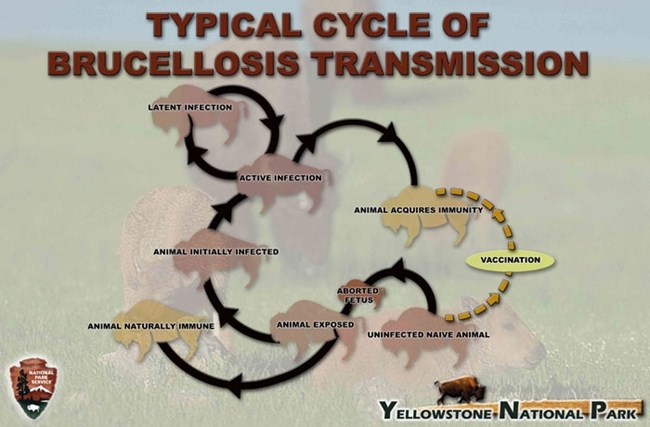Last updated: November 6, 2017
Article
Bison Bellows: Brucellosis

NPS Graphic
Countless elements influence and threaten the health of wildlife species and the habitats they live in. Disease, such as brucellosis, represents one of these aspects and can pose a significant risk to the conservation of species, especially a species such as the American bison.
Brucellosis is an infectious disease caused by the bacterium Brucella abortus and is commonly transmitted between elk, bison, and domestic livestock. Many people believe that European livestock introduced the non-native bacterium to both bison and elk before 1917. The disease normally occurs through the contact with or ingestion of infectious birth tissues and induces spontaneous abortions and stillbirths. Fatality is very rare, but it can cause substantial disabilities and diminish reproductive success. What is interesting is that the Brucella abortus bacterium has evolved host-specific mechanisms to hide from or manipulate cellular immunity. In other words, bacteria can wait for the opportunity to infect females during pregnancy when females' natural immunity is lower. This evolutionary adaptation allows the Brucella bacteria to establish persistent infections within their hosts.
Brucellosis functions within a complex network of interactions between animals, humans, and the environment. The loss of habitat and land-use changes due to human development increases the proximity of bison, livestock, and humans to each other. As a result, the risk of spreading diseases between these species increases. To minimize the effects on humans and livestock, a nationwide program was created in 1934 to eradicate the disease. With the exception of wildlife species in Yellowstone National Park, the program successfully eliminated the disease in the United States. This prevalence in the greater Yellowstone ecosystem has led to decades of conflict regarding disease transmission and reduction and the management of bison and elk.
Disease management is necessary due to the potential negative impact to the conservation of the American bison and the possible risks to domestic livestock productivity. Management is extremely complex because of the desire to preserve free-ranging wildlife species while limiting the potential spread and impacts of the disease. It is ultimately a balance between conservation, effective disease management, and risk analysis. Potential management practices must include integrative methods such as maintaining separation between livestock and bison, managing habitat to reduce disease transmission, and reducing the prevalence of the disease in wildlife. It is crucial that managers practice adaptive management in order to address the uncertainties and complexities associated with the disease. This adaptive management framework can inform decision-making processes by recognizing how multivariate and integrative brucellosis disease management is. It is crucial to develop and implement new practices to enhance progress and avoid undermining the conservation of bison.
Did you know?
Brucellosis remains one of the most common zoonotic diseases in the world with over half a million new cases reported every year. There are ten species within the genus Brucella and can infect a variety of species such as bison, humans, bullfrogs, marine mammals, wood rats, and camels.
